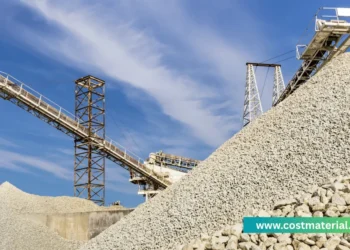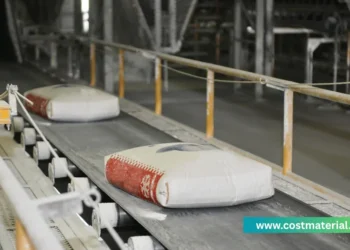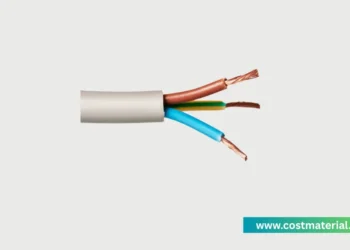Are you planning a construction project in the Philippines? Understanding material costs is crucial. The CHB Price List is often a starting point. Concrete Hollow Blocks (CHB) are fundamental. They form the backbone of many structures. Knowing their price helps in accurate budgeting. This guide provides updated 2025 information. It helps you build efficiently and affordably.
1. Introduction to CHBs
Concrete Hollow Blocks are widely used. They are common in Philippine construction. CHBs are versatile building materials. They are made from cement, sand, and aggregates. Their hollow cores reduce weight. This also offers insulation properties. CHBs come in various sizes. Standard sizes include 4-inch, 5-inch, and 6-inch. Larger 8-inch blocks are also available. Understanding these variations is key. It helps in project planning. Knowing the correct CHB Price List is essential.
CHBs provide structural integrity. They are durable and long-lasting. Moreover, they offer fire resistance. They contribute to sound insulation. This makes them ideal for various applications. From residential homes to commercial buildings, CHBs are a staple. They are used for walls, fences, and foundations. Their widespread availability is an advantage. This consistency helps builders. It simplifies material sourcing.
Furthermore, CHB construction is relatively fast. Masons are familiar with the process. This speeds up project timelines. This also impacts labor costs. The simplicity of use is a major benefit. Therefore, CHBs remain a popular choice. They balance cost-effectiveness with performance. This makes them a go-to material.
2. Factors Affecting CHB Prices
Several elements influence the CHB Price List. Understanding these factors helps predict costs. First, raw material costs play a big role. Cement, sand, and gravel prices fluctuate. These are primary ingredients for CHBs. Energy costs also contribute. Fuel prices impact manufacturing and transport. This directly affects the final price.
Second, block size and type matter. Larger blocks naturally cost more. Higher strength blocks also have a premium. For instance, 6-inch blocks are pricier than 4-inch. Load-bearing blocks are more expensive. Non-load-bearing blocks are lighter. They are typically cheaper. Always specify your needs. This ensures accurate pricing.
Third, location greatly affects prices. Prices vary across regions. Metro Manila might have different rates. Provinces far from production centers face higher transport costs. Accessibility to materials is a factor. This contributes to regional price disparities. Fourth, supplier competition impacts prices. Areas with many suppliers might see lower prices. Areas with fewer options could have higher rates.
Fifth, purchase volume can offer discounts. Bulk orders often come with savings. Contractors benefit from larger purchases. Small quantities might incur higher per-piece costs. Negotiate with suppliers for big projects. Lastly, economic conditions play a part. Inflation impacts all material costs. Demand and supply dynamics shift prices. Keep these factors in mind.
3. Average CHB Price List Philippines 2025
Here is an estimated CHB Price List for 2025. These are average figures. Actual prices may vary by location and supplier. For accuracy, verify with local supplier.
CHB Thickness (inches) | PSI Rating | Approximate Price per Piece (PHP) |
| 4 | 120-150 PSI (Non-Load Bearing) | ₱14.00 – ₱17.00 |
| 4 | 350-500 PSI (Load Bearing) | ₱19.00 – ₱23.00 |
| 4 | 700 PSI (Load Bearing/High Strength) | ₱25.00 – ₱30.00 |
| 4 | 1000 PSI (Very High Strength/Specialty) | ₱32.00 – ₱40.00+ |
| 6 | 120-150 PSI (Non-Load Bearing) | ₱17.00 – ₱20.00 |
| 6 | 350-500 PSI (Load Bearing) | ₱22.00 – ₱26.00 |
| 6 | 700 PSI (Load Bearing/High Strength) | ₱28.00 – ₱35.00 |
| 6 | 1000 PSI (Very High Strength/Specialty) | ₱38.00 – ₱45.00+ |
| 8 | 350-500 PSI (Load Bearing) | ₱25.00 – ₱30.00 |
| 8 | 700 PSI (Load Bearing/High Strength) | ₱32.00 – ₱40.00 |
| 8 | 1000 PSI (Very High Strength/Specialty) | ₱42.00 – ₱50.00+ |
These prices reflect general market trends. They are influenced by many factors. Always consider the strength (PSI) of the block. Higher PSI generally means higher cost. Discuss your specific project needs with suppliers. This ensures you get the right materials.
4. Understanding CHB Specifications
Not all CHBs are created equal. Specifications impact performance and price. PSI (Pounds per Square Inch) indicates strength. Common strengths include 450 PSI, 700 PSI, and 1000 PSI. Higher PSI blocks are denser. They offer superior structural integrity. Therefore, they are more expensive.
Block dimensions also vary slightly. While named 4-inch, 5-inch, etc., actual measurements can differ. Standard dimensions are usually 40cm x 20cm (length x height). The thickness varies by type. Always confirm the exact dimensions. This ensures proper calculations for your project.
Furthermore, there are different classifications. Load-bearing CHBs are designed for structural support. They carry the weight of the building. Non-load-bearing CHBs are for partitions. They do not support structural loads. Using the correct type is vital. It affects safety and compliance. Misuse can lead to structural issues. This also impacts the overall project cost. Knowing these details helps you navigate the CHB Price List effectively.
Quality control is paramount. Good CHBs are uniformly shaped. They have smooth surfaces. They are free from cracks or chips. Poor quality blocks can compromise structure. They may also increase waste. Always purchase from reputable suppliers. Insist on quality standards. This ensures durability and safety.
5. Tips for Buying CHBs
Buying CHBs wisely saves money. First, always get multiple quotes. Compare prices from different suppliers. This includes local hardware stores. Also check with larger distributors. Second, inquire about bulk discounts. Large orders often qualify for lower unit prices. Plan your purchase carefully. Consolidate your material needs.
Third, consider delivery options. Some suppliers offer free delivery for large orders. Others charge based on distance. Factor in transport costs when comparing prices. Fourth, inspect the quality upon delivery. Check for broken or damaged blocks. Reject substandard items. Ensure the blocks meet your specifications.
Fifth, buy slightly more than calculated. Account for breakage and waste. A 5-10% buffer is usually recommended. This prevents costly delays. It avoids extra delivery fees for small top-up orders. Finally, plan your delivery schedule. Ensure you have storage space. Protect blocks from rain and mud. This maintains their quality.
Building strong relationships with suppliers helps. Consistent purchases may lead to better deals. Ask about their return policy. Understand terms and conditions. These practical tips enhance your procurement process. They ensure you get the best value. This optimizes your CHB Price List expenditure.
6. CHB vs. Alternative Materials
While CHBs are popular, alternatives exist. Understanding them helps in decision-making. Autoclaved Aerated Concrete (AAC) blocks are one option. They are lighter than traditional CHBs. AAC blocks offer superior insulation. They are also fire-resistant. However, AAC blocks are generally more expensive. Their installation methods can also differ.
Another alternative is pre-cast concrete panels. These are manufactured off-site. They offer fast construction times. They also provide excellent quality control. However, they require heavy equipment for installation. Their initial cost can be higher. Similarly, steel framing with various cladding materials is an option. This offers flexibility in design. It can be faster to erect. Yet, steel is a premium material.
Furthermore, traditional wood framing is still used. It is common in rural areas. Wood offers flexibility and warmth. However, it is susceptible to pests and fire. Maintenance can be higher. Each material has pros and cons. They each have different cost implications. The choice depends on project specifics. Consider budget, structural needs, and timeline.
Compare the overall cost of ownership. This includes material, labor, and maintenance. Do not just look at the upfront material cost. CHBs remain a cost-effective choice. They offer a good balance of features. This makes the CHB Price List highly relevant. It is a benchmark for many projects.
7. Impact of Location on Pricing
Location significantly affects the CHB Price List. Prices vary widely across the Philippine archipelago. For instance, Metro Manila might have competitive prices. This is due to many suppliers and high demand. Proximity to manufacturing plants also reduces costs. Luzon, especially areas near cement factories, might see stable prices.
However, prices in Visayas and Mindanao can differ. Island provinces face higher logistics costs. Transporting materials across seas adds expense. Fuel surcharges also play a role. Remote areas might have fewer suppliers. This can lead to higher prices due to limited competition. Local taxes and fees also impact costs.
Furthermore, local market dynamics matter. Specific demand in a region affects pricing. Seasonal demand also plays a role. During peak construction seasons, prices might rise. During off-peak times, they might stabilize. Always inquire about prices in your specific area. Do not rely solely on general national averages.
Consult local hardware stores first. They provide the most relevant pricing. Then, expand your search to regional distributors. This strategy ensures you get accurate quotes. It helps manage your budget effectively. Geographic factors are crucial. They directly influence your final CHB Price List.
8. Delivery Costs Explained
Delivery costs are often overlooked. They can significantly impact your total CHB Price List. Most suppliers charge separately for delivery. The cost depends on several factors. Distance from the supplier to your site is primary. Longer distances mean higher fuel consumption. This translates to higher fees.
Quantity ordered also affects delivery. Large bulk orders might qualify for free delivery. Smaller orders might incur a fixed fee. This fixed fee can be substantial per piece. Truck size and capacity also matter. Larger trucks can carry more. They may have higher per-trip charges. However, they reduce the number of trips needed.
Site accessibility is another factor. Difficult-to-reach sites might incur extra charges. Steep roads or narrow passages complicate delivery. Always confirm delivery terms beforehand. Ask for a breakdown of costs. Avoid hidden fees. Clarify if unloading services are included. Some deliveries are curbside only.
Planning delivery logistics is vital. Ensure your site is ready. Provide clear instructions to the delivery team. This avoids delays and extra charges. Efficient delivery management saves money. It keeps your project on schedule. Therefore, factor delivery into your overall CHB Price List calculation.
9. Budgeting for CHB Installation
The CHB Price List covers material costs only. Installation involves significant additional expenses. Labor costs are a major component. Skilled masons are crucial. Their daily rates vary by region. Project complexity also affects labor hours. More intricate designs require more time.
Mortar and plastering materials are needed. Cement, sand, and water are essential. Rebar is also often used for reinforcement. These contribute to the overall wall cost. Scaffolding, tools, and equipment are also expenses. These are often included in labor rates. However, specialized tools might be rented.
Consider the “per square meter” cost of a CHB wall. This includes materials and labor. This metric gives a better overall picture. It combines material purchase with installation. Get detailed quotes from contractors. Ensure they break down material and labor costs. This allows for clearer comparison.
Unexpected costs can arise. Account for potential reworks or material waste. A contingency budget is always wise. Typically, 10-15% of the total project cost. This covers unforeseen issues. Proper budgeting is key to a successful project. It ensures you stay within financial limits. It makes the CHB Price List just one part of the puzzle.
10. Future Outlook for CHB Prices
Predicting future CHB Price List trends is challenging. However, certain factors influence outlook. Global economic conditions play a role. Inflationary pressures might continue. Energy costs are always a concern. Fluctuations in crude oil prices impact transport. Geopolitical events can also disrupt supply chains.
Local demand for construction remains high. Infrastructure projects boost demand. Private residential construction is also robust. High demand can push prices up. However, increased production capacity could stabilize them. Government policies on housing and construction also matter. They can influence market dynamics.
New technologies might impact production efficiency. Automation could reduce labor costs. Sustainable practices might lead to new materials. These could offer alternatives to CHBs. Monitoring these trends is important. Stay informed about market updates. Consult industry reports for deeper insights.
In conclusion, expect some volatility. Prices may fluctuate throughout the year. However, CHBs will remain a staple. Their affordability ensures continued use. Adapt your budget accordingly. Maintain flexibility in your plans. This proactive approach helps manage costs effectively.
11. Summary and Key Takeaways
The CHB Price List is a vital tool. It helps in planning construction projects. Prices vary significantly. Factors like size, strength, and location matter. Always get multiple quotes. Compare offers from different suppliers. Consider bulk discounts for savings.
Delivery costs are an important addition. Factor them into your total budget. Understand CHB specifications. Choose the right type for your project. Load-bearing vs. non-load-bearing is critical. Quality inspection upon delivery is necessary. Avoid damaged blocks.
Labor costs are separate from material costs. Budget for installation, mortar, and rebar. Consider the “per square meter” cost. This provides a comprehensive view. Keep a contingency fund ready. This covers unexpected expenses.
Did you find this blog post helpful? Share it to others! For more construction material price lists, check our other blog post.





